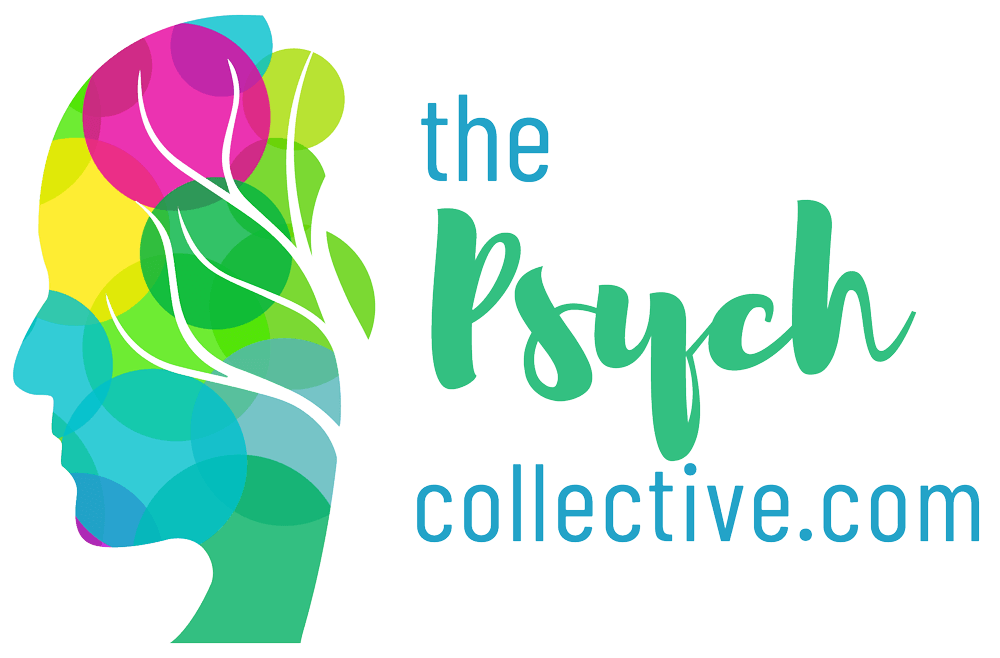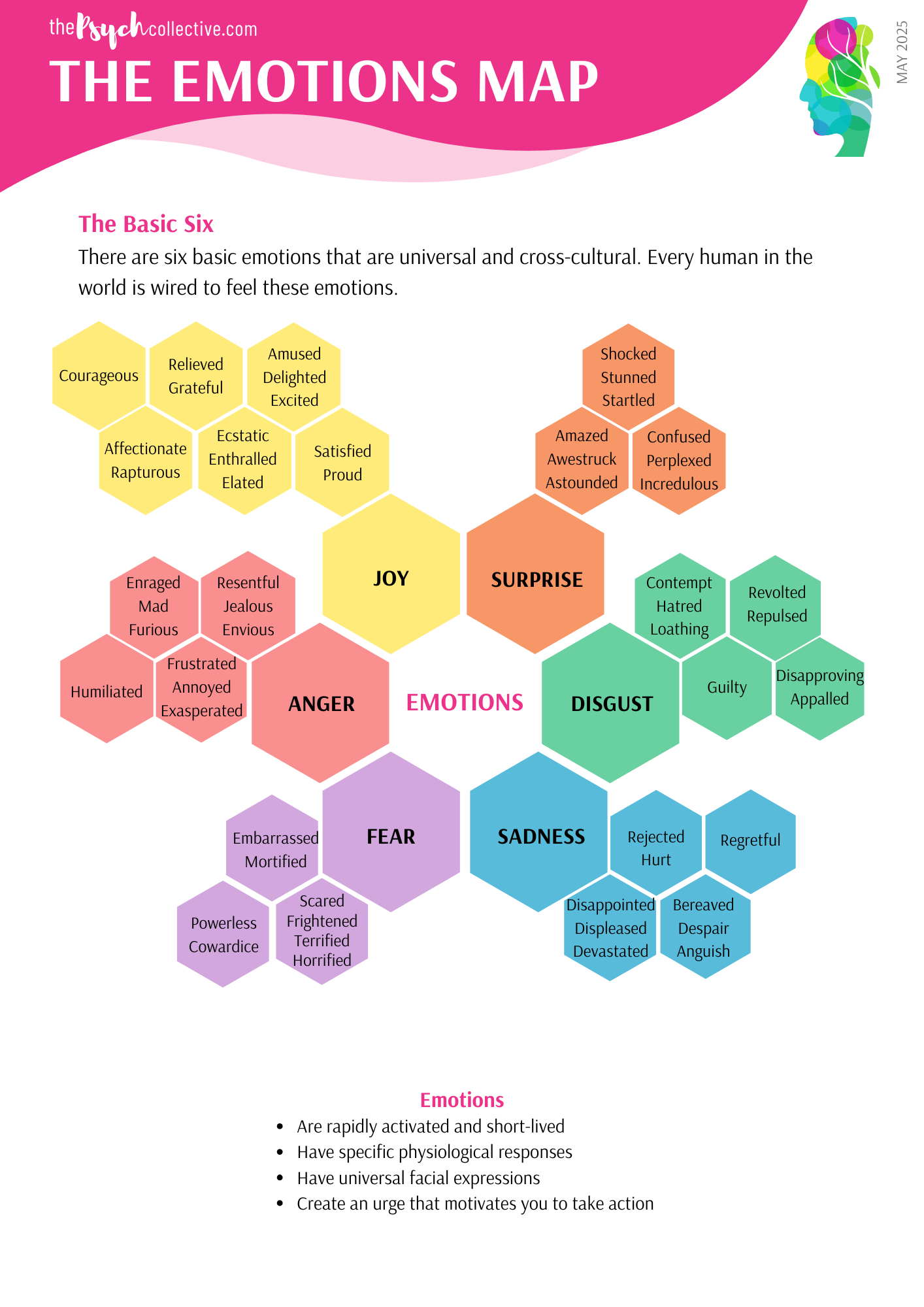Feeling Cards for Kids
Helping Kids Name What They Feel:
The Story Behind the Feeling Cards for Kids
By Jess O'Garr, Clinical Psychologist
During the last school holidays, my nine-year-old daughter came up to me and said, “Hey Mama, can I go on Canva and make some posters about feelings to talk to my friends?”
As a clinical psychologist, this wasn’t just music to my ears—it lit a little creative spark. I replied, “You know what? I’ve always had this idea of making up feeling cards for kids. Do you want to do a joint project with me?”
She agreed with the kind of enthusiasm only a school-holiday project with screen time can bring. That one moment of curiosity sparked what would become the Feeling Cards for Kids—a therapeutic tool created by professionals, tested by families, and brought to life by kids.
Over the next week, my daughters and I watched Inside Out 1 and 2, read storybooks about emotions, and combed through The Psych Collective Emotion and Mood maps. Both girls helped brainstorm feeling words and grouped them into categories, not realising how much I was making them practise their spelling.
Armed with an extensive list, we turned to Canva and my girls appointed themselves as Image Directors. They had a lot of fun selecting pictures to matched the feeling words. We made the decision to avoid using facial expressions as many kids struggle with them. My girls had a lot of giggles, and have declared their favourite images as the bored bunny and the grumpy cat.
What started as a school holiday project quickly evolved. The kids were excited to show their cards to their teachers, especially because, in their own words, “the emotion stuff we do at school is kind of boring and doesn’t really explain much.”
That’s when I knew we were onto something.
What Are the Feeling Cards for Kids?
The Feeling Cards for Kids are a full set of 78 beautifully illustrated, colour-coded cards covering the six core emotion families:
- Joy (17 cards)
- Anger (14 cards)
- Sadness (15 cards)
- Fear (13 cards)
- Disgust (7 cards)
- Surprise (5 cards)
Each feeling card includes:
- A feeling word and synonyms.
- A relatable description written in a kid’s voice
- The word used in a sentence
- Physical sensations and body clues
- Common behaviours associated with the feeling
- Helpful “watch-outs” for when they might get carried away with a feeling
- Guidance on how to take care of this feeling.
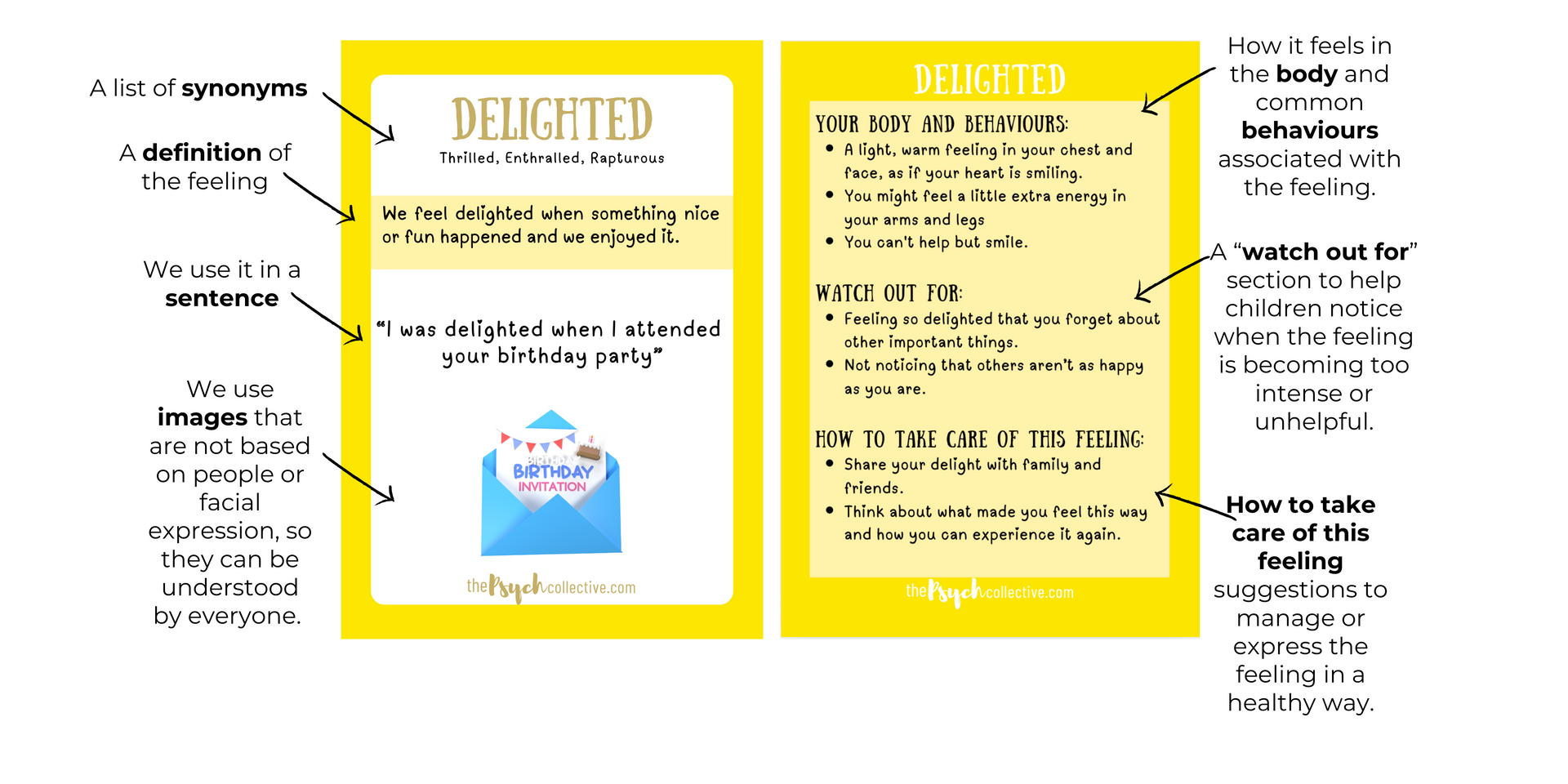
Why We Made These Cards (And Why They Matter)
We created these cards because, despite the growing awareness around emotional intelligence, so many tools for kids still fall short. They’re often too basic, with just a facial expression and a label, so they don’t reflect the full emotional landscape that children experience daily.
But kids are feeling things all the time. Sometimes they don’t have the words. Sometimes they don’t have the confidence. And sometimes, they don’t even realise what they’re feeling until it bursts out of them as a tantrum, a shutdown, or an “I hate you” at the dinner table.
What they do need is:
- The language to name their feelings
- The skills to care for those feelings
- The confidence to share those feelings with others
When kids can recognise, understand, and express their emotions, they build skills that will serve them throughout their entire lives—at home, at school, in friendships, and eventually in workplaces and relationships.
We're Teaching Skills too
We’ve also created 7 bonus “Feeling Skills” cards—regulation tools that kids can use to calm themselves down, tune into what they’re experiencing, and respond in a healthy way. These aren’t just descriptions of feelings—they're tools for emotional growth.
The skills cards give kids actionable tools like deep breathing, grounding techniques, self-validation, and cooling down—practical strategies that even adults can benefit from.
What to do with the Feelings Cards for Kids
To help parents, teachers or care givers navigate the deck of feeling cards for kids, and yes, it's a big deck, we have included an instruction sheet with some tips and ideas on how to use these cards with your kids.
You'll get a copy in each box, plus we'll attach a digital copy with your order in case it gets lost or hidden by kids who think they're funny (ask me about the letterbox keys going "missing" for 3 days. Spoiler alert - it wasn't funny).
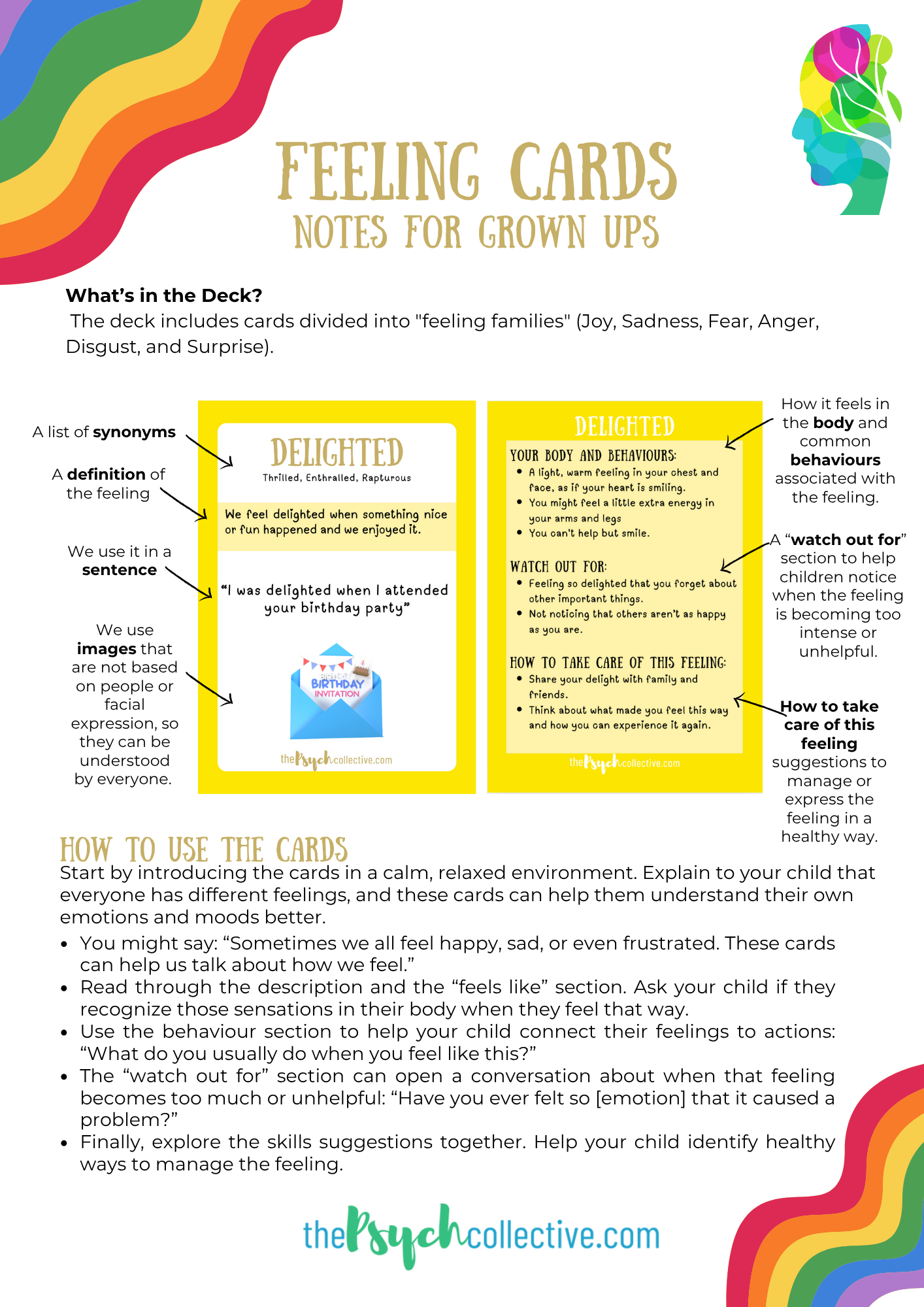
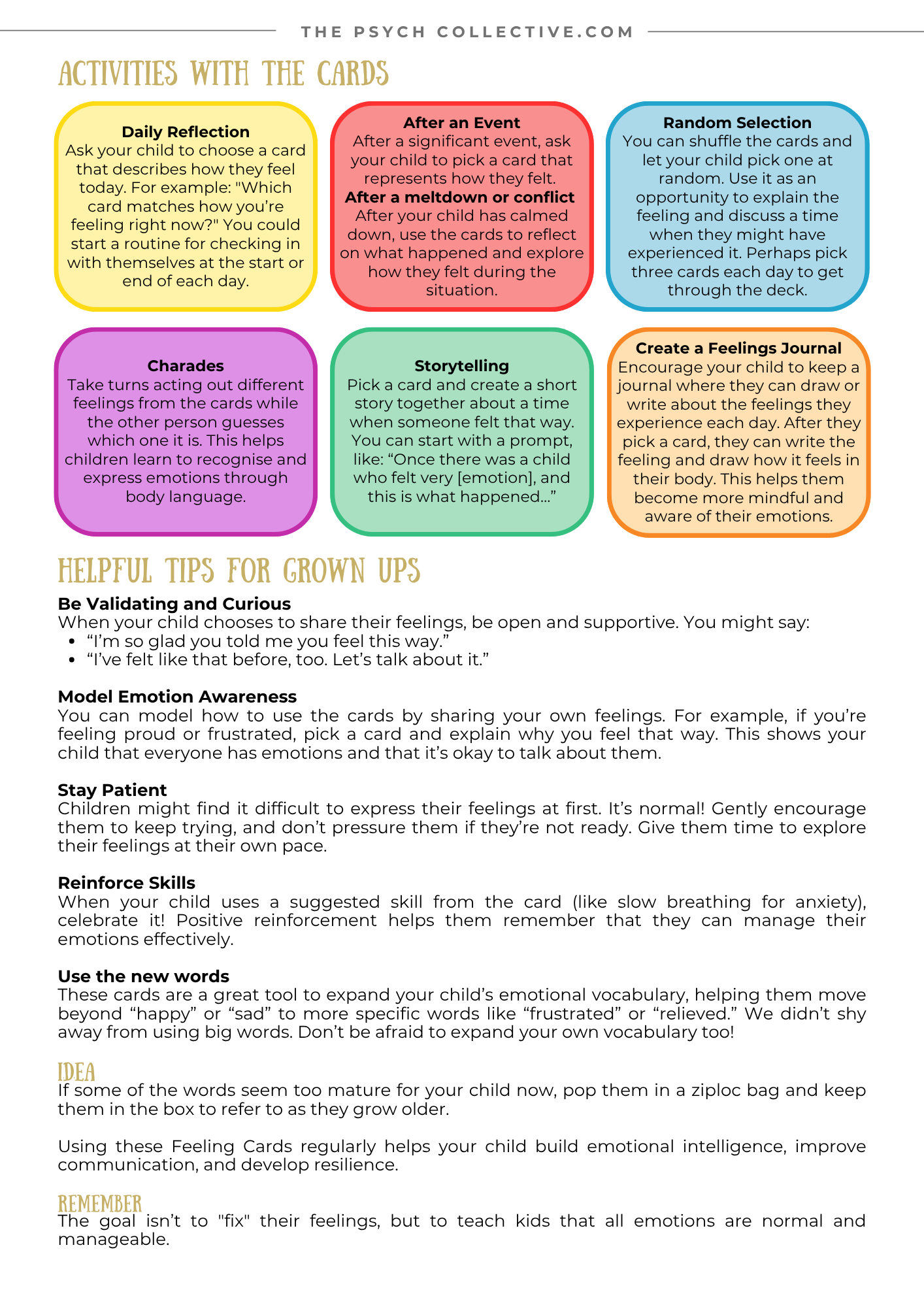
What Emotional Literacy Actually Looks Like
In our house, emotional literacy isn’t a worksheet—it’s a conversation. It’s my daughter stomping out of the room, then returning ten minutes later with a red card in hand and saying, “I’m feeling vengeful.” (Yes. Vengeful. She got that one from the cards.) It’s my other daughter handing me a blue card and quietly saying, “I think I’m feeling lonely today.”
Sometimes they can’t name the exact emotion—but they’ll say, “I’m feeling yellow,” or “It’s a big red one.” Depending on how intense the emotion is, the card might get placed in my hand… or launched across the room. Either way, I know they’re communicating—and that’s the whole point.
The cards give them a safe, playful, and emotionally intelligent way to say: “This is what’s going on inside me.”
What Makes These Cards Different?
There are plenty of feelings charts, flashcards, and “emotion posters” out there—but what we’ve created here goes far deeper than surface-level emojis. Here’s what sets these apart:
Rich, Nuanced Language
We’ve gone well beyond happy/sad/angry to include words like:
- Vulnerable,
- Jealous,
- Discouraged,
- Hopeful,
- Confident,
- Appalled,
- Sulky,
- Ecstatic,
- Paranoid…
Because kids feel complex things, too. They deserve a vocabulary that reflects that.
A little tip:
We want to expand children's vocabulary, so this deck of feeling cards is very comprehensive. Some cards may feel a little too mature for your child's age and that's ok. Just pop some cards in a ziploc bag and keep them at the back of the box so they can grow into them when they're ready.

Practical Emotion Regulation Tools
The 7 Feeling Skills Cards help kids manage big feelings in safe ways. These include:
- Self-validation: “It’s okay to feel this way.”
- Grounding: “What’s real and safe right now?”
- Cool down: “Let’s calm the body to calm the mind.”
- Deep breathing, self-soothing, LEAN, and more
These aren’t just for kids who are struggling—these are for all kids, because all kids have emotions, and all kids can learn to regulate them.
Co-designed with Kids
This wasn’t a top-down adult project. Kids were the creators and design engineers. They picked the imagery, shaped the tone, and gave feedback on the language. These cards speak to kids because they came from kids.
Dr Al's kids got involved, and they love the stressed out pigs.
Designed by Mental Health Professionals
As a clinical psychologist (Jess) and psychiatrist (Dr Al), we’ve brought our years of clinical knowledge into every single word. These cards are grounded in evidence-based practice but speak in a child’s voice. That’s a rare combo.
How to Use the Feeling Cards
Whether you’re a parent, teacher, psychologist or carer, these cards are flexible and easy to use:
Feeling Check-ins
Do a daily or weekly check-in:
“Pick a card that matches how you feel today.”
This is a great ritual at the dinner table, during morning circle time, or as part of therapy sessions.
Support During Big Feelings
When your child is upset, say:
“Want to go get your feelings box and find a card?”
This gives them a sense of control and invites connection rather than conflict.
Teach Emotion Regulation
Use the skills cards as teaching tools:
- Practise deep breaths when everyone’s calm
- Role-play using grounding techniques
- Make a feelings plan with your child for what to do when they're overwhelmed
Creative Storytelling
“Pick three cards and tell a story about a character who feels these things.”
This can help kids explore emotions indirectly, especially if they’re nervous to talk about themselves.
Not Just for Kids...
While these cards were created with children in mind, we’ve been surprised (though maybe not that surprised) at how many adults have connected with them too.
Some of my patients who’ve played with the cards in therapy have said:
“I finally have the words for what I’ve felt for years.”
“I didn’t realise how often I shut my own feelings down.”
Many adults struggle with identifying or expressing feelings—a trait sometimes referred to as alexithymia. These cards gently invite people back into their emotional world, without shame or overwhelm. So yes, these are for your kids—but don’t be surprised if they end up helping you too.
Why Emotional Literacy Is a Skill for Life
We all want our kids to grow up resilient, kind, and self-aware. That journey begins with teaching them that feelings are not problems—they’re messages. They help us understand what matters, what needs attention, and when something isn’t right.
When children can name and regulate their emotions, they:
- Form healthier relationships
- Make better decisions
- Cope more effectively with stress
- Develop confidence and empathy
- Grow into emotionally intelligent adults
We believe that emotional literacy is one of the greatest gifts you can give a child—and it starts with something as simple as a deck of cards.
From Our Homes to Yours
Our kids are proud of the cards they helped make. They’ve used them, argued over their favourite characters (still the bored bunny vs. the stressed pig), and are counting down the days until they can take them to school
We hope your family loves these cards as much as ours do.
We made them to fill a gap—but more than that, we made them to give kids a voice. We want every child to grow up knowing their feelings are welcome, their words are powerful, and they don’t have to figure it all out alone.
Order your set of Feeling Cards for Kids
and help your child become a Feelings Superstar—one card, one conversation, one breath at a time.
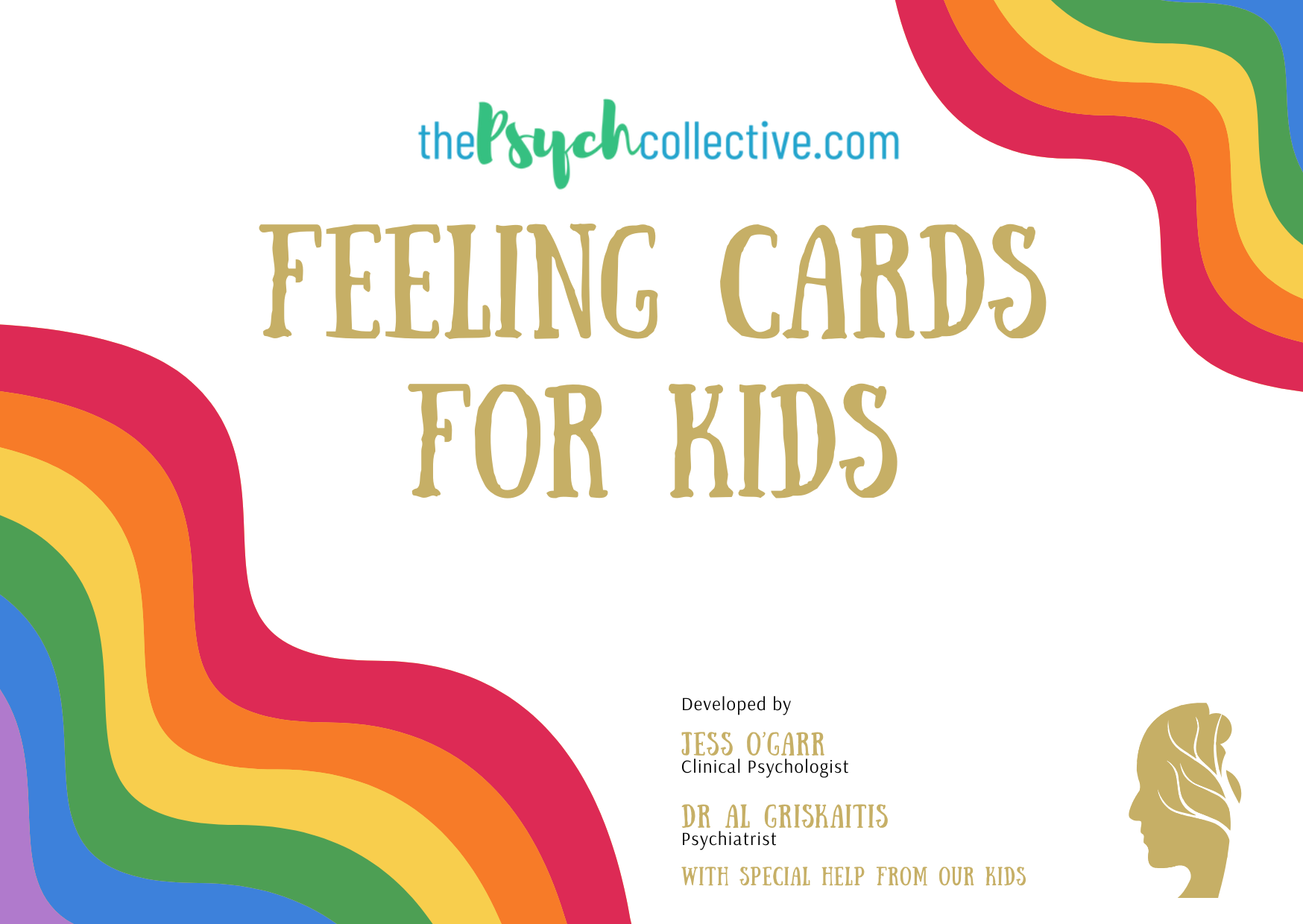
Support kids to name what they feel, understand what it means, and choose what to do next.
Add to cart and bring emotional literacy into your home, classroom, or clinic.
Order from our Resources page here
Share
Categories
About Our Resources
We offer actionable resources and teach real skills to help people make meaningful change in managing mental health issues through different modes depending on people's learning preferences including infographics, text, worksheets, handouts and video.
